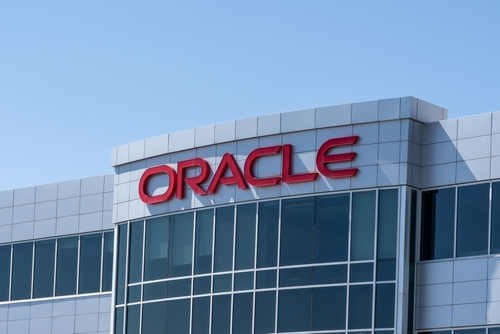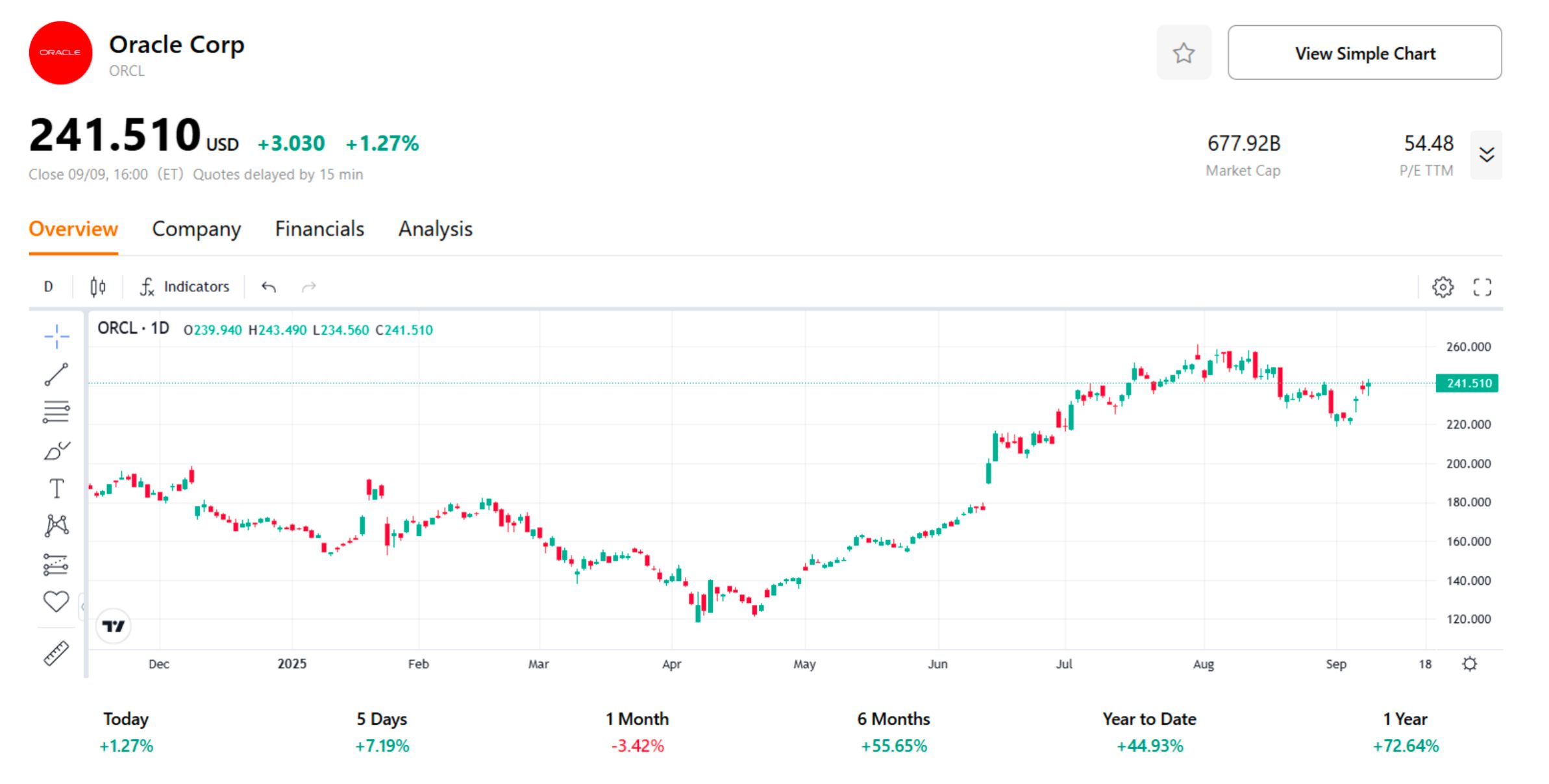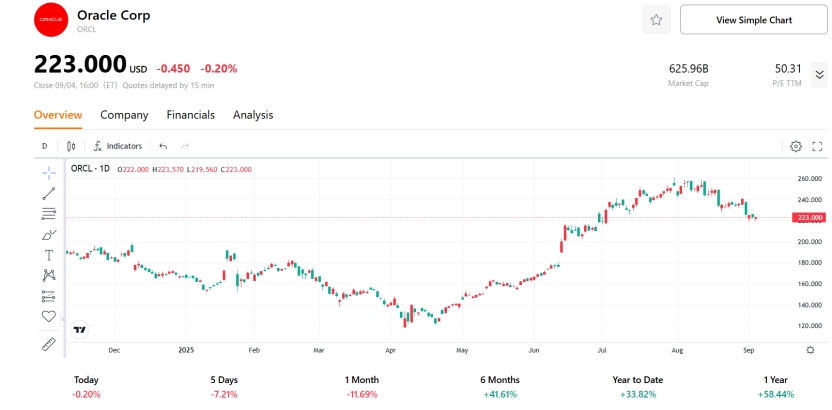Oracle Q1 FY2026 Earnings: Cloud Surge and Record RPO Fuel AI Optimism

TradingKey - Oracle Corporation (NYSE: ORCL) posted mixed Q1 FY2026 results, with total revenue and adjusted EPS slightly below consensus amid a shift to cloud services, but cloud revenue beat expectations with robust 28% growth. A massive RPO backlog of $455 billion, up 359% YoY, guarantees multi-year AI and cloud demand visibility, while management raised Cloud Infrastructure revenue guidance. Shares surged over 28% in after-hours trading, reflecting investor focus on accelerating cloud momentum and AI infrastructure buildout.

Source: TradingKey
Key Financial Results
Metric | Q1 FY2026 | Q1 FY2025 | Beat/Miss | Change (YoY) |
Total Revenue | $14.93B | $13.3B | Miss | +12.2% |
Adjusted EPS | $1.47 | $1.39 | Miss | +5.8% |
Cloud Revenue | $7.2B | $5.6B | Beat | +28% |
Cloud Infrastructure (OCI) Revenue | $3.3B | $2.2B | – | +54% |
Non-GAAP Operating Margin | 41.5% | 43% | Miss | -1.5pp |
Remaining Performance Obligations (RPO) | $455B | $99B | – | +359% |
Source: Oracle, TradingKey
Segment and Strategic Performance
Oracle’s Q1 FY2026 results show strong momentum in cloud infrastructure, AI, and database services, driven by significant capacity expansion and a rapidly growing backlog.
Cloud Infrastructure and AI: OCI revenue jumped 54% to $3.3 billion, led by a 57% rise in consumption driven by demand for GPU-powered AI workloads. New AI tools from NVIDIA and early Blackwell GPU deployments in major data centers are key drivers, while Oracle’s AI Database, designed to vectorize enterprise data for AI, is gaining traction. However, GPU supply shortages and the pace of data center ramp-up remain bottlenecks, limiting immediate revenue conversion. The current run rate points to an ambitious 77% cloud growth for FY2026, targeting $18 billion, with a long-term goal of $144 billion by FY2029.
Cloud Applications and Database: Cloud applications grew 10% to $3.8 billion, with strategic back-office apps like Fusion ERP and HCM up 16%. Autonomous database revenue expanded 43%, approaching $2.8 billion annualized, aided by AI enhancements. Multicloud database revenue soared 1,529%, supported by 34 data centers across AWS, Azure, and Google Cloud, set to triple by year-end. This reflects growing customer preference for Oracle’s cross-cloud database solutions in complex, regulated environments.
Backlog and Revenue Visibility: The backlog (RPO) surged to $455 billion, up $317 billion from the prior quarter, especially in cloud contracts, rising nearly 500%, driven by substantial AI deals with hyperscalers and large enterprises. This backlog provides rare visibility into future revenue streams, supporting confidence in Oracle’s near-term growth outlook. CEO Safra Catz expects RPO to top $500 billion soon, cementing this positive outlook.
Margins, Cash Flow, and Capex: Margins dipped modestly to 41.5% from 43% due to a higher cloud mix and increased AI investments. Non-GAAP Operating income still rose 9% to $6.2 billion. Operating cash flow remains strong at $8.1 billion; however, free cash flow continues to be negative due to sustained capital expenditures of $8.5 billion in Q1, driven by ongoing data center capacity expansion. Oracle’s $11 billion cash reserve supports this buildout alongside share repurchases and debt reduction, while dividends remain stable.
Guidance and Management Commentary
Q2 FY2026 Outlook: Oracle expects total revenue growth of 14–16% in USD, with cloud revenue growing 33–37%. Non-GAAP EPS is forecasted between $1.61 and $1.65, representing 10–12% growth, assuming a 19% tax rate. OCI growth should stay around mid-50%.
FY2026 Outlook: OCI revenue is guided to grow 77% to $18 billion, with total cloud up 40–45%. Operating income is set to rise mid-teens percentage, supported by roughly $35 billion in capital spending mostly on data centers. Long-term targets will be updated in October.
Management Comments: Larry Ellison, Chairman and CTO, called AI training a multi-trillion-dollar market with uses in robotics and drug design. CEO Safra Catz highlighted strong OCI demand and a large backlog, calling Oracle the de facto cloud for many customers. Supply constraints remain but new capacity and data center expansions should ease them.
Conclusion and Outlook
Oracle’s Q1 FY2026 results confirm strong AI-driven cloud growth, supported by a massive backlog that points to durable multi-year demand. OCI remains on track to reach its revenue target despite challenges from GPU supply constraints and significant capital investment. Operating leverage is expected to improve as cloud consumption continues to ramp.
Strategic AI partnerships with NVIDIA and hyperscalers, along with expansions in sovereign cloud offerings, have strengthened Oracle’s market leadership. Shares surged to $300 in after-hours trading, trading near 35x forward earnings. Robust demand and a growing AI ecosystem position Oracle well for sustained growth in AI and cloud services throughout FY2026 and beyond.
Oracle Q1 FY2026 Earnings: Can Cloud and AI Drive the Next Stock Rally?
TradingKey - Oracle Corporation (NYSE: ORCL) will report Q1 FY2026 results after the close on Tuesday, September 9, 2025, with the webcasted conference call scheduled for 4:00 PM CT / 5:00 PM ET, making the print a fresh read-through on enterprise cloud, AI infrastructure demand, and multicloud adoption into FY2026. With shares up 34% YTD on AI and cloud momentum, the quarter will test whether Oracle can convert its expanded backlog and capacity additions into sustained revenue, EPS, and OCI consumption acceleration.

Source: TradingKey
Market Forecast
Metric | Q1 FY2026 Forecast | Q1 FY2025 Actual | Change (YoY) |
Total Revenue | $15.01B | $13.3B | +12.9% |
Adjusted EPS | $1.47 | $1.39 | +5.8% |
Cloud Revenue | $6.9B | $5.6B | +23% |
Non‑GAAP Operating Margin | 44% | 43% | +1pp |
Source: Oracle, Nsadaq, TradingKey
-aed28d6554ce4524878beecef3e9297f.jpg)
Key Investor Focus Areas
Cloud infrastructure and AI: Oracle Cloud Infrastructure (OCI) is Oracle’s infrastructure as a service platform for compute, storage, networking, databases, and GPUs that powers enterprise and AI workloads. Q1 OCI growth is expected to be around the mid 40% range as newly added capacity comes online, set against management’s FY2026 goals of over 70% OCI growth and over 40% total cloud growth if supply converts into sustained consumption; NVIDIA Blackwell rollouts and native NVIDIA AI Enterprise/NIM services in OCI are expected to support training and inference at scale, while GPU supply and data center readiness will determine how quickly demand converts to reported revenue and margins.
Backlog and RPO: RPO is expected to step higher from the Q4 FY2025 base of $138B as AI infrastructure and multicloud activity continue; quarterly results will hinge on when large agreements activate and how fast workloads ramp, which drives revenue recognition and operating leverage.
Multicloud and partnerships: Triple digit multicloud database growth and 23 live multicloud data centers, with additional sites progressing across AWS, Azure, and Google Cloud, are expected to extend cross cloud reach and support share gains as enterprises standardize database services; pass through to reported results depends on converting in flight sites and deepening partner attach.
Margins, Cash, and Capex: Non GAAP operating margin is expected around the mid 40s percent near term as cloud mix scales against elevated AI infrastructure investment; FY2026 capex is expected to exceed $25B for revenue generating data center equipment, supporting capacity adds tied to AI and cloud demand. Free cash flow deployment remains focused on capacity expansion, share repurchases, and debt management, while pricing, promotional activity, and the phasing of new capacity relative to consumption are set to shape near term margin contours.
Recent Events and Regulatory Trends
AI partnerships: Oracle and NVIDIA announced native availability of NVIDIA AI Enterprise tools and NIM microservices on OCI, alongside Blackwell GPU deployments to power reasoning models and AI agents; timing of monetization depends on GPU supply and workload ramp.
Capacity ramp: OCI is rolling out GB200 class NVL72 systems and building large Blackwell clusters, adding headroom for fiscal 2026 cloud acceleration as new regions and availability domains reach steady consumption.
Regulatory: Tightening data sovereignty and AI governance standards highlight the need for distributed/sovereign cloud options, embedded policy controls, and auditability in OCI’s AI stack, particularly in regulated sectors where compliance can lengthen activation timelines.
Conclusion
Oracle’s Q1 FY2026 is expected to meet consensus with potential upside. Momentum hinges on three signals: evidence that new capacity is translating into steady OCI usage, RPO moving higher with clearer activation timing, and margins holding despite higher AI capex. If guidance and commentary confirm these positives, the FY2026 acceleration case strengthens, with shares potentially moving toward $250. If supply constraints, activation delays, softer cloud momentum, or margin pressure surface, a 5–10% pullback is plausible and a cautious stance is warranted.









